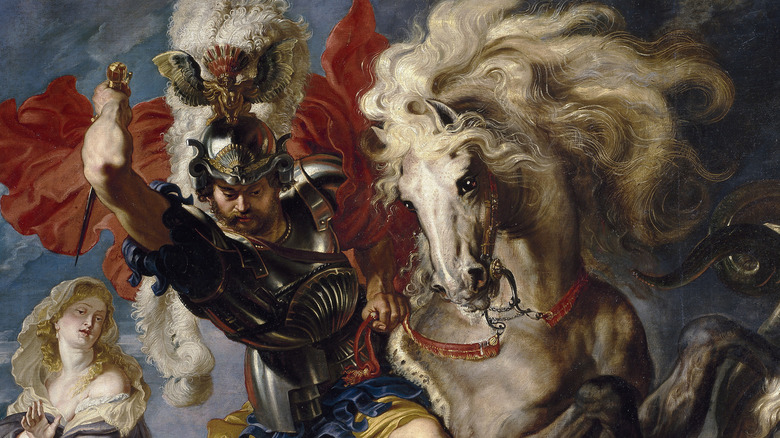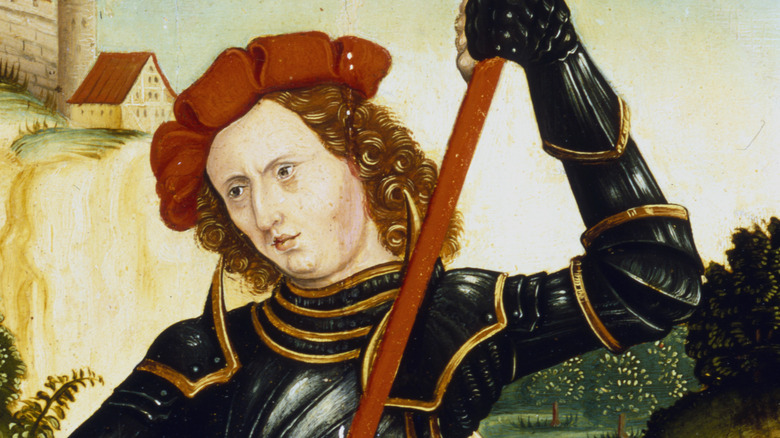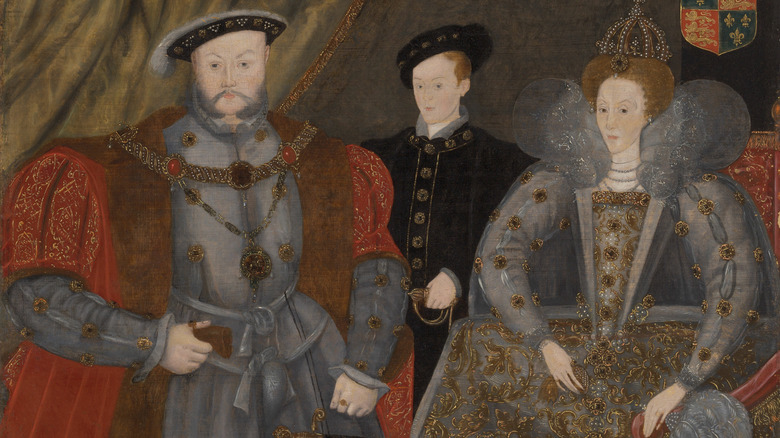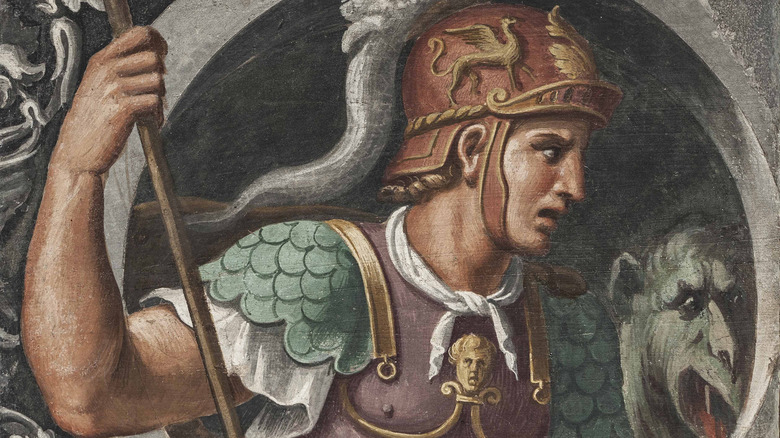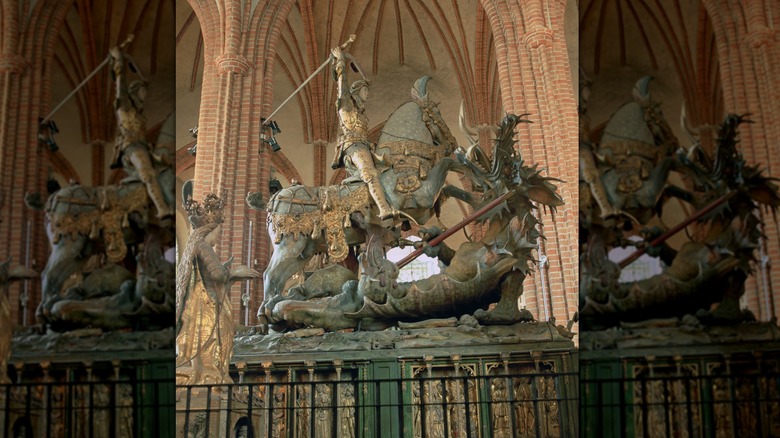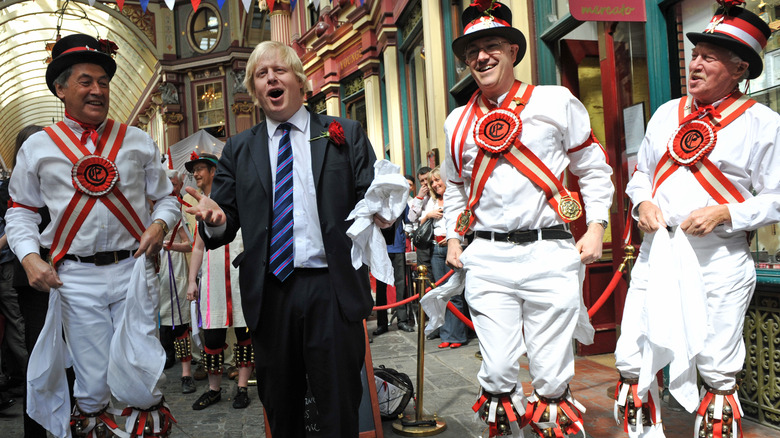Things Everyone Gets Wrong About Saint George
A dragon has been demanding tribute from a poor, plighted village. First, the monster wants their livestock, then it demands human sacrifice, on threat of poisoning the entire village by its toxic breath. By lots are the victims chosen, until the king's daughter must take her turn. But as she makes her way to the dragon's lair, a dashing knight comes upon her, hears her story, and vows to free the village of its menace. Upon his horse he gives battle to the dragon, finally pinning it to the earth with his trusty lance. The knight leads the dragon back to the village, where he beheads it, distributes his reward among the poor, and brings Christianity to the relieved people.
This is possibly the most famous story of Saint George, an archetypal battle between man and dragon. The story was commemorated in medieval and Renaissance art and sculpture. And since the 14th century, George has been the patron saint of England. His cross, red on white, is the country's flag. The chapel where many kings and queens of Britain are buried bears his name. And there's been a push — not without controversy — to make Saint George's Day a bank holiday in England, as Saint Patrick's Day is to Ireland.
That Saint George should be so heavily associated with England, however, is a surprising development of his legend. Much of the famous iconography around George has strayed far afield from what we know of him, starting with his nation. Here are a few things you probably have wrong about George of Lydda.
Saint George wasn't English and never visited England
Many historical figures have legends that loom larger in our collective consciousness than the known facts of their lives. But in the case of Saint George, legends are almost all we have to go on. We know very little about George, and it can't even be totally confirmed that he ever existed (though records and traditions dating to shortly after his reported death in 303 A.D. indicate that he did).
But one thing we do know about George is that he was no Englishman. He was likely born in modern-day Turkey, by tradition in Cappadocia, and he was likely Greek and wealthy. His mother is believed to have been a Greek Palestinian, and one tradition holds that she took her son to her homeland after his father died (via Rosemary Guiley's "The Encyclopedia of Saints"). It was in Palestine where he's believed to have died. He may have traveled during his lifetime, but it is extremely unlikely that George ever went as far north or west as England.
It isn't necessary, however, for a patron saint of a country to be from that country; only that they exhibit ideals that a nation aspires to. Venice, Portugal, Catalonia, Genoa, and Ethiopia all have George as their patron saint. The English venerated him as early as the eighth century, and Richard the Lionheart invoked George's protection during his time in the Crusades. When Edward III founded the Order of the Garter under George's patronage, George became associated with an ideal image of kingship promoted by Edward, and his connection to England has endured through the centuries.
The English haven't always loved Saint George
Chivalry and heroism helped draw medieval kings of England to Saint George. But the Reformation saw a massive upheaval in religious thought throughout Europe, England very much included. Under the Tudor dynasty, there was a massive reduction in holy days, and Saint George's Day got the axe. Perceptions of George soured as anti-Catholic sentiment rose; books declared him a heretic and a murderer, while others rejected him for his association with the Crusades.
And yet the cult of Saint George endured. His was the only religious flag to survive the revisions to the Prayer Book under Edward VI, and his legend found renewed enthusiasm among royalty and nobility. In part, this was due to a shift in perceptions of George from a religious Catholic figure to a nominally Protestant but largely secular one. This image makeover was laundered through the legend of King Arthur; the Tudors relied heavily on Arthurian lore in building their own image and even claimed descent from him. The Elizabethan allegory "The Faerie Queen" made George the embodiment of Protestant conversion via his dealings with Arthur.
In his new guise, George saw his legend considerably expanded in Tudor England. It was in this era that stories of him visiting England were invented. And his holy day was restored in 1552, only a few years after it had been struck from the calendar.
Saint George wasn't a knight
It goes without saying that Saint George did not literally fight a dragon. But if we consign that aspect of his story to myth, we must also do so with the claim that he was a knight. Indeed, having lived and died hundreds of years before the concepts of chivalry and knighthood as we know them were conceived, he could hardly have been the archetypal gentleman-warrior in shining armor.
But he was, we think, a soldier. Early accounts of George's life say that sometime after returning with his mother to Palestine, he enlisted in the Roman army and became an officer of high rank. But his duties conflicted with his faith; George was born a Christian and practiced Christianity at a time when Christians were scapegoats of the Roman empire. The Emperor Diocletian decreed in 303 A.D. that all Christians serving in the Roman army should recant or be expelled and that all soldiers should make sacrifices to the gods of Rome.
George would do neither. He is sometimes credited as the martyr of Eusebius's "The Church History" who tore up Diocletian's edict, though this is disputed by historians (per the Catholic News Agency). But whether he made such a scene or not, George clung to his faith and suffered for it. He is said to have given away his wealth and freed the people he enslaved before being arrested and put to torture, an episode sometimes embellished by Roman depravity and angelic visits. By tradition, George was executed on April 23 at Nicomedia. It was his martyrdom, not his dragon-slaying, that made him an early Christian hero.
The dragon was a late edition to the legend of Saint George
Saint George may have been revered as a martyr by the early church, but there's no denying that a battle with a dragon catches attention and makes for a more universal hero. The story of George and the dragon is an old one, but not quite as old as you might think. Its origins are rather obscure, and it's far from the only story that puts saints up against monsters; Scotland's Loch Ness Monster may have its origins in a legendary encounter with Saint Columba. Such accounts could have been adaptations of ancient Egyptian and Greek myths, adapted to represent the triumph of the church over paganism. In the case of Saint George, some believe that the dragon was a representation of Emperor Diocletian, though there are versions of the legend where the dragon battle and George's persecution by the emperor are distinct episodes.
Whatever its origins, the story of Saint George and the Dragon didn't appear until hundreds of years after his death. A tradition of larger-than-life stories about George's life has been traced back to the sixth century, but the dragon was only introduced somewhere around the 10th or 11th century, by the Eastern Orthodox church. The most famous account of George and the dragon in the West was written by Jacobus de Voragine in 1265, in his "The Golden Legend" collection. It set the action around Silene, possibly a representation of Cyrene, Libya, and had George use a cross as well as a lance in his battle with the dragon.
Misconceptions about Saint George have fueled England's culture wars
All these centuries later, the story of Saint George has been pulled into the culture wars. Elements of the far-right have latched onto Saint George's Cross as a symbol, invoking it while promoting racist rhetoric — George's non-English life story need not matter. More benign appeals to George as a symbol of English identity and unity have been met with scorn, cynicism, and even outright rejections of the idea of national pride.
But in the pushback against such appropriation, elements of the political left have made their own mistakes. It's become common to see descriptions of George as Turkish or Arab, despite his probable Greek background; the Greeks were prominent in Cappadocia and Palestine at the time George is believed to have been born. Writer Yiannis Baboulias, who readily acknowledged George's prominence in other nations beyond England, lamented in The Spectator that such culture war sniping made not only George — but the various peoples he's been labeled as — props in largely online petty feuds.
